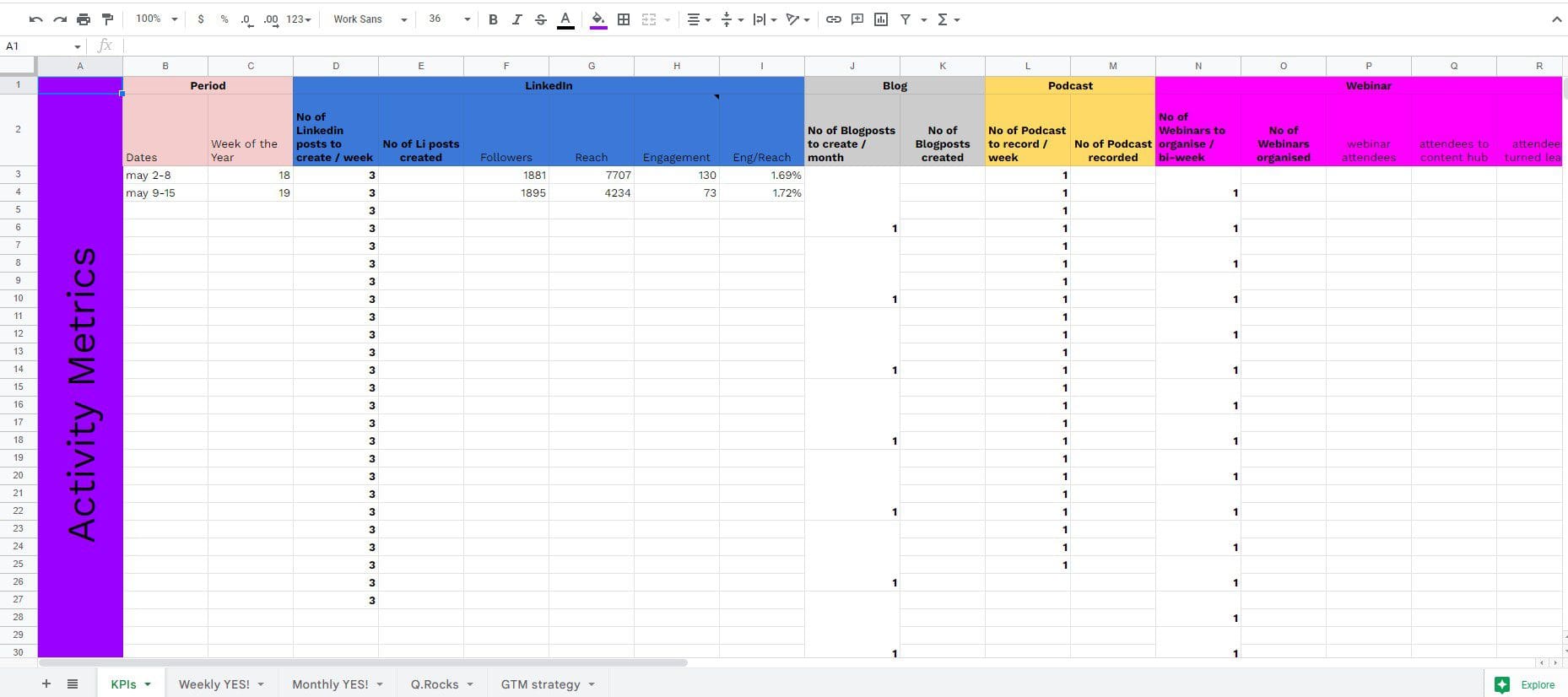Here’s 3 truths about KPIs:
- A lot of companies don’t measure KPIs
- A lot of companies don’t measure KPIs right
- 1 and 2 are huge problems.
The former is easier to solve. The latter, not so much. Because measuring the wrong KPIs is going to make you feel great about your business, even when things are going alarmingly bad.
A few fancy charts are not going to save your business from going down. But, signs of it happening show up long before you think they do. From measuring the wrong KPIs to measuring the right ones but doing nothing about it, there are a lot of mistakes businesses make when measuring results.
The question remains, what do you track and how do you track it?
KPIs – how many is too many?
“You can't manage what you can't measure.”
Peter Drucker
You can’t attribute all favorable customer actions to one single marketing action. So, you should be measuring more than the 3-5 KPIs leadership suggests you measure. If you stick to measuring only a few lagging metrics (metrics that only measure results), you’re not going to be able to figure out what’s wrong early on in the process. Sometimes, you might also be caught up measuring the wrong metrics, like website visits and leads.
But, the other extreme would be to obsessively measure everything. And it’s oh-so-easy to fall into that trap. Sure, multiple dashboards with complex numbers and a plethora of metrics seem fancy. But is it useful? Usually not. You’d just be swimming in a pool of noise and information and yet be just as uninformed. (Oh the irony!)

Either one of those thought processes leads to disaster. Why?
Because this is how marketers learn to only focus on and fund activities that are easily measurable. Not everything that works is measurable, at least not easily. Focusing on quick outputs and discarding the inputs is only a numbers game, one you can’t even win.
Ultimately, what you need to understand is that just because the results aren’t measurable or don’t show fantastic results early on, doesn’t mean it’s doing poorly. Sometimes, good things take time.
Which KPIs should you
measure in B2B marketing?
The entire point of Key Performance Indicators is the ‘key’ part. Meaning they have to be a few, super important metrics. C-level executives don’t care about the LI likes on your company’s post, even though your team spent 30 entire minutes on Canva designing an infographic for it.
When establishing KPIs, it’s important to distinguish between the nice-to-haves and the must-haves. If the number of visitors on your website is down by 12%, that’s fixable. But a 12% drop in MQL to SQL conversion rate is slightly more alarming.
The C-suite is usually concerned with the 2-3 most important, usually lagging indicators that tie back to revenue. But when only marketing is concerned, you’d want a lot more KPIs that measure demand generation, lead generation, and the likes.
Note:
Every little activity can’t be attributed to revenue and outcome – because it’s simply not realistic. The sales cycle is long and complex, so the actions taken by your buyers are influenced by multiple factors. Sure, the buyer liking your LI post 4 months ago and subscribing to your newsletter last week had something to do with them buying your $60k/month software. But, correlation is not causation. Your LI post is not the reason they bought the software, just a part of it.
Activity Metrics
At Klear, we believe in measuring inputs before measuring outputs. With our clients, the focus is on measuring what we’re creating and how much of it. Of course, we track output in the form of engagement and reach too. The primary goal is to be consistent. Below is the screenshot of how we track all important activity and result indicators:
Creating a post for LI, a blog for the website, a 60-min podcast episode AND a tweet can seem daunting, but you can always repurpose your content. They’re not 4 different unique pieces of content, they stem from the one that was created first, most likely the podcast or the blog.
The good thing here is that they’re intertwined. You can use an LI post to talk about an upcoming webinar, the webinar can have a quick reference to your latest blog, the blog can talk about your podcast, you get the point.
But at the same time, when a piece is bad (adds little to no value), it’ll probably do bad across all platforms. If the quality is great but only did well on some platforms, the problem is with the algo or content distribution. This way, you know what’s working and what isn’t.
Apart from measuring daily activities from week to week, you should also be measuring ‘goal vs. actual achieved’ on a quarterly, mid-yearly and annual basis. These goals should then be divided into monthly and weekly goals.
Some of these goals aren’t always quantifiable, the key is to have clarity on your progress and switch things up when you need to.
TL;DR:
- Measure a few important metrics, not all of ‘em. They’re called ‘key’ performance indicators for a reason.
- Don’t tie everything back to revenue. But, tie quite a few of them to revenue.
- All activities cannot be measured — doesn’t mean they’re unimportant.
- Don’t assign undue importance to low value producing activities just because they are easily measurable.
Related Posts
- Building a tech company on culture - ep 13
When a tech company that started from a college dorm in the remote hills of…
- SDR superpowers for account-based marketing - ep 8
Be'Anka Ashaolu, VP of Marketing at Propel and Dan from Klear dive-into some exciting parts…
- How to attract talent: employer branding - ep 27
When tech companies hire our marketing firm to help 'em get big clients, the conversation…


